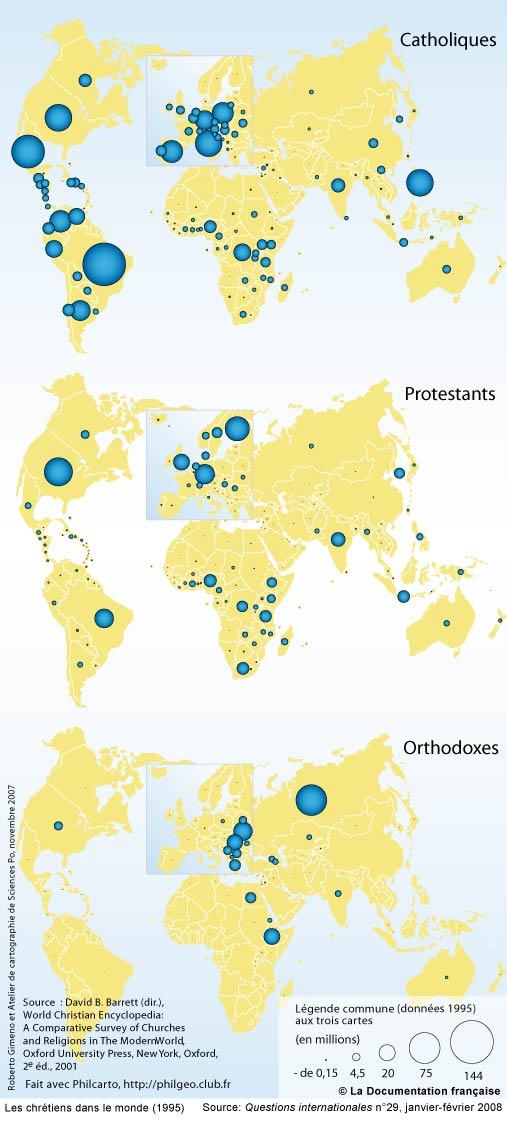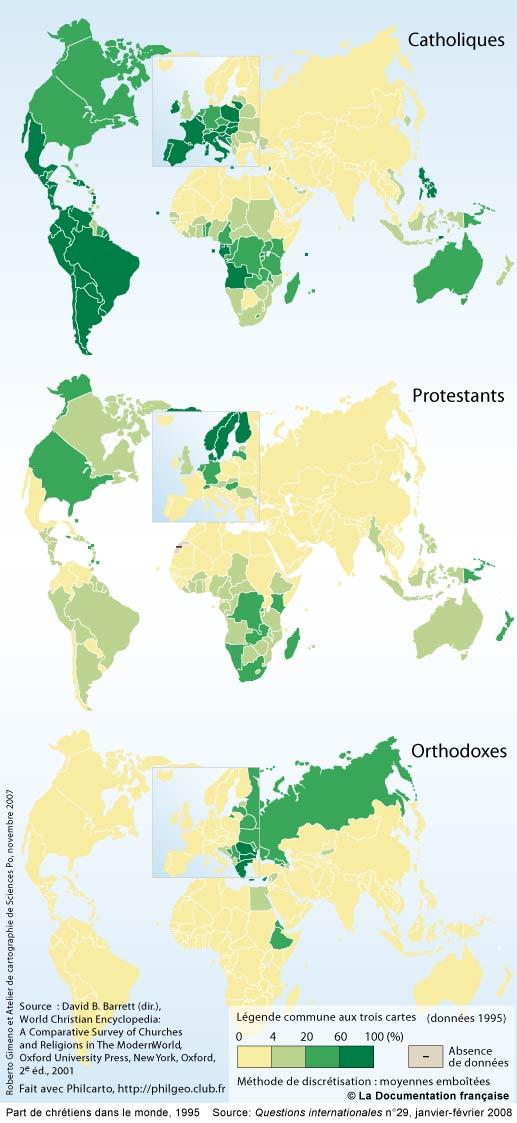9. Christians worldwide
With 2.5 billion followers, that is a third of humanity (2010), Christianity is the first world religion. Its territorial expansion ended in the 20th, but the demography of the Christendom knows of deep changes: dynamism in the developing world, weakening in the old Christian homes of the North, the vitality of the other religions...
The Christian churches in the World
The maps shown are based on data collected by David B. Barrett’s team. David B. Barrett was an Anglican priest who undertook to track the global status of faiths based on missiometrics. Their purpose is to measure the progress of conversions to Christianity around the world, from 1800 to 2025 by projection. The underlying database was built from data published by national and international bodies. Sociologists have objected that this method is not based on science but on a religious premise, in this case evangelical: the correlation between the second coming of Christ and the number of Christians, which will then reach a critical mass. The metrics developed would hence help predict the timing of biblical prophecies. Although open to debate, the statistics produced are the only ones available on a global scale, and they provide figures with precision.

Questions internationales, n° 29, Le christianisme dans le monde, janvier-février 2008 Roberto Gimeno et Atelier de cartographie de Sciences Po, novembre 2007 http://www.ladocumentationfrancaise.fr/cartes/religions/c001024-les-chretiens-dans-le-monde-1995
The proportion of Christians in the World

Questions internationales, n° 29, Le christianisme dans le monde, janvier-février 2008
Roberto Gimeno et Atelier de cartographie de Sciences Po, novembre 2007
http://www.ladocumentationfrancaise.fr/cartes/religions/c001026-part-de-chretiens-dans-le-monde-1995
Melanie Ferreira, "Rio de Janeiro, the most Evangelical of Catholic cities"
The content of the document is taken from an article in Témoignage chrétien (Christian Witness), a weekly publication that is critical of the establishment and acts in favor of interreligious dialogue. The article discusses the Evangelical movement’s dynamism and diversity. It notably highlights the relative difficulty that the more formal mainline Churches have in attracting followers.
“Although it remains the world’s largest Catholic country, given its Catholic population of 123 million (out of a total population of 194 million), Brazil has experienced exponential growth in Evangelical faiths, in common with the whole South American continent.
According to the Brazilian Statistics Institute (IBGE), which publishes every decade a census of religions, the proportion of Catholics in the country has dropped 10 points in ten years from 74% in 2000 to 64.6% in 2010 (compared to 92% of Brazilians who declared themselves Catholics in 1970). Conversely, the number of Evangelicals surged, growing from 5% to 22% of the population in forty years. Among the 27 states in Brazil, Rio has broken all records, with less than 46% of its population identifying itself as Catholic [...].
The Evangelical Churches have gained ground largely in poor areas: in the affluent districts of Rio, more than three quarters of the population still identify themselves as Catholic.
"These Churches are more flexible, porous, and can move into any area they choose. They provide conviviality, sociability, and a large support network,” says Rafael Soares Garcia, a historian and jurist at the Pontifical Catholic University of Rio de Janeiro (PUC), and a specialist in Favelas.
Father Manuel Manangão, the episcopal vicar responsible for social affairs in the Archdiocese of Rio, recognizes that Evangelical churches demonstrate greater proximity with residents. "People in these poor areas suffer from many deficiencies. And the Catholic Church is not always there to provide solutions. Believers then turn to those who are present, and sometimes it is these Evangelical groups," he said with some embarrassment [...].
Beyond their strong presence, the Evangelicals’ success is also explained by the diversity of their Churches. From the Assemblies of God and the Contemporary Christian worship, to the Universal Church of the Kingdom of God, the visions they develop of society, the world, and of life, are extremely different, sometimes opposed as well [...] .
Their worships are spectacular, and the figure of the devil is present everywhere. In this evening of June in Vidigal, the Neopentecostal preacher at the mike invites the audience to raise their arms in the air and shout, "Come unto me Jesus, come unto me!" A bit later, believers who are possessed go on stage, the devil is expelled by all in unison, people shout, people cry.
For Father Ricardo, curate of one of the Catholic churches in the neighborhood, "the Evangelical’s sermons and worship services are more captivating. Among Catholics, the oral discourse is more distant, more contained."
The Catholic Church, conscious of the Evangelical phenomenon, has begun to examine ways to deal with it. Among the initiatives developed in this direction is the Catholic Charismatic Renewal, a movement that brings together Catholics and copies the worship practices of Pentecostal churches.
They thus meet in small groups every Monday evening at the Church of Vidigal, in an atmosphere far different from Sunday Mass. "Communication is more open, we do not pray in the same way," said Alexandra whose 13-year old niece accompanies prayers on her guitar.”
Melanie Ferreira, "Rio de Janeiro, the most Evangelical of Catholic cities",
Témoignage chrétien, July 20, 2013. Trans. Christopher S. Wheatley.
http://temoignagechretien.fr/articles/rio-de-janeirola-plus-evangelique-des-villes-catholiques






